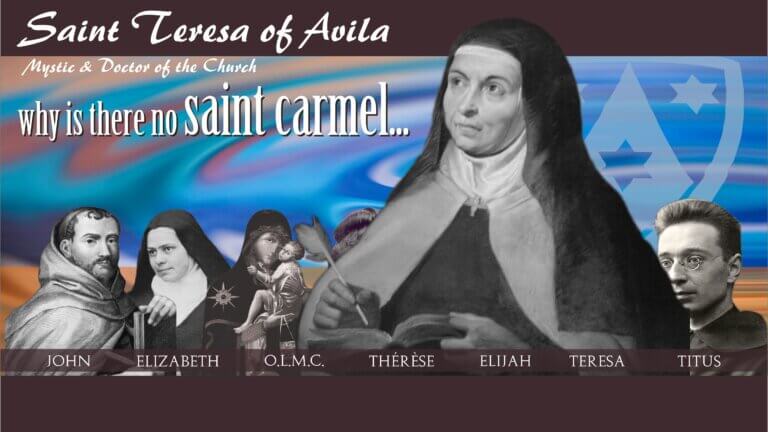
谁是阿维拉的特蕾莎?
(资料来源:OCARM.OG)
10 月 15 日 盛宴
她的家人称她为特蕾莎-德-塞佩达-伊-阿胡马达(Teresa de Cepeda y Ahumada),她后来成为了卡梅尔的改革者、苦修卡梅尔派修女和修士的母亲、"精神之母"(梵蒂冈大教堂中她的雕像下镌刻着这一称号)、天主教作家的守护神(自 1965 年起)和教会博士(1970 年),是继圣凯瑟琳-锡耶纳之后第一位获得最后一个称号的女性。她于 1515 年 3 月 28 日出生于西班牙卡斯蒂利亚的阿维拉,1582 年 10 月 4 日在萨拉曼卡附近的阿尔巴-德-托尔梅斯去世(由于当年的格里高利历法改革,翌日正式为 10 月 15 日,因此作了更正)。她于 1614 年被封圣,1622 年被封为圣徒,她的节日是 10 月 15 日。
她的一生需要从天主为她制定的计划、她内心的巨大渴望、她年轻时所患的神秘疾病(以及她终生遭受的健康问题)和她对神恩的 "抗拒 "来理解,她为此自责不已。1535 年 11 月 2 日,她离家出走,进入了阿维拉的化身卡梅尔。一方面是由于社区的普遍条件,另一方面是由于她自身的精神困境,她在 39 岁时经过一番挣扎才实现了她所谓的皈依。但是,在多位精神导师的帮助下,她开始大步迈向完美。
1560 年,人们首次萌生了建立一个新的卡梅尔的想法,在那里可以更严格地遵守教规。两年后,这个想法得以实现,圣约瑟夫修道院在没有任何捐赠的情况下成立,并 "遵循原始教规":我们需要清楚地理解这句话,因为无论在当时还是后来,它都是一个怀旧和 "英雄主义 "多于实际的概念。五年后,特蕾莎从当时正在西班牙访问的骑士团团长约翰-巴普蒂斯特-罗西那里获得了增加修道院数量的许可,并获得了建立两个沉思的加尔默罗修士团体(后来被称为 "戒律 "修士)的许可。圣特蕾莎去世时,教改中已有 17 座修女修道院,修士团体的数量也很快超过了最初的数目,其中一些是经罗西院长批准建立的,但另一些,尤其是安达卢西亚的修士团体,则是在违背罗西院长意愿的情况下建立的、有些修士团体是经罗西总主教批准建立的,但有些修士团体,特别是在安达卢西亚的修士团体,则是在违背总主教意愿的情况下建立的,这些修士团体的建立依赖于使徒查访员、多明我会的巴尔加斯和年轻的弃绝加尔默罗会的杰罗姆-格拉西安(特蕾莎的亲密精神伴侣,她发誓只要不违背上帝的律法,她就会为他做任何事)的批准。
随后发生了一系列令人不快的争吵,由于民政当局和其他外人的干涉,争吵变得更加严重,直到 1581 年,戒律派被组建成一个独立的省。圣特蕾莎在信中写道:"现在,我们所有人,不论是守戒派还是圣约派,都和平相处,没有什么能阻挡我们侍奉上主"。
圣特里萨是天主教灵修史上最重要的人物之一。她的作品--尤其是最著名的四部作品(《生命》、《圆满之道》、《宅邸》和《基础》)--连同她更多的历史著作,包含了涵盖整个灵修生活的教义,从最初的步骤直到在内部城堡的中心与天主亲密接触。从她的书信中可以看出,她忙于处理各种各样的日常问题。她关于灵魂与天主合一的教义(这是她亲身经历的教义)沿袭了加尔默罗会的传统,这一传统在她之前就已存在,她本人对这一传统也做出了卓越的贡献,不仅丰富了这一传统,还将这一传统传给了她的灵性儿女们,以及她不遗余力服务的整个教会。当她临终时,她唯一的喜悦就是能够确认 "我是教会的女儿"。
此外,我们还在视频下方推荐了一些资源,供希望进一步了解这位了不起的加尔默罗会圣徒的人参考。
要查找更多资源,了解更多有关阿尔伯特、《加尔默罗会规》或任何加尔默罗会圣徒和加尔默罗会灵性的信息,我们建议您:
有关教育机会,包括网络研讨会和 "反思日 "活动,请访问 https://www.carmeliteinstitute.net
有关卡梅尔派教徒撰写的其他印刷资料,请查阅 https://www.icspublications.org
我们希望您能喜欢 "为什么没有圣卡梅尔? YouTube 频道。 我们邀请您再次观看今后的视频,并祈祷这些思考能激励您更深入地了解我们令人惊叹的加尔默罗会圣徒大家庭。
圣母纯心会加尔默罗派教徒效忠耶稣基督,以先知和沉思的姿态祈祷、共同生活和服务。 在以利亚和玛丽的启发下,在加尔默罗会规的指引下,我们在美国、加拿大、秘鲁、墨西哥、萨尔瓦多和洪都拉斯见证了长达八百年的精神转变传统。
请考虑支持他们的使命
https://carmelitemedia.tiny.us/supportpcm
捐款。
